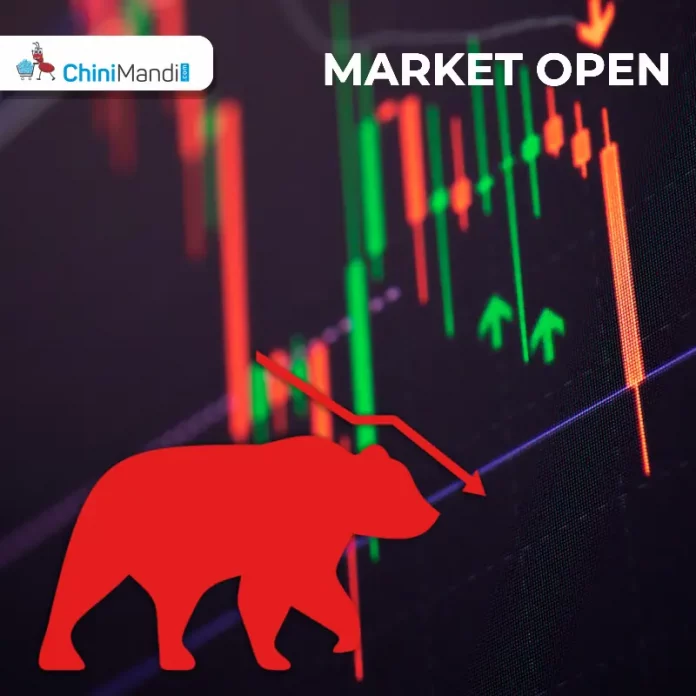Mumbai (Maharashtra): The stock market began the week on a subdued note as key indices opened lower on Monday.
The BSE Sensex fell by 346.25 points, opening at 76,863.65, reflecting a 0.45 per cent decline. Meanwhile, the NSE Nifty 50 dropped by 99.75 points to 23,401.35, marking a 0.42 per cent decrease.
The initial hours of trading indicated a bearish sentiment, driven by broader market concerns amidst global economic uncertainty.
At 10:17 am, Sensex was trading 159.21 points lower at 77,050.69, whereas Nifty was trading 51.50 points down at 23,449.60.
Among the Nifty 50 companies, only 4 stocks advanced while 42 declined, showcasing weak market breadth. The top gainers included Sun Pharma, Wipro, ITC, ICICI Bank, and Apollo Hospitals.
On the other hand, the major losers were CIPLA, IndusInd Bank, Tata Steel, Adani Ports, and Bajaj Finance. The lacklustre performance was influenced by mixed global cues and recent profit booking trends.
Last Friday’s session saw the Sensex closing 269.03 points lower at 77,209.90, and the Nifty settled at 23,501.10, down by 65.90 points.
The market was weighed down by selling pressure, leading to a cautious start this week. The Bank Nifty index also opened lower, down by 381.20 points or 0.74 per cent to 51,280.25, signalling a broad-based decline across sectors.
Technically, the Nifty 50 showed potential bearish signals with a bearish engulfing pattern on the daily chart, suggesting indecision among traders.
Varun Aggarwal, founder and managing director, Profit Idea, said, “A small bearish candle on the weekly chart indicated a formation of a bearish spinning top pattern, pointing towards potential further weakness if confirmed in the coming days. The market is closely watching these technical indicators for signs of direction.”
He added, “Globally, market trends were mixed, adding to the cautious sentiment. In the United States, the S&P 500 and Nasdaq closed lower on Thursday due to disappointing economic data and cautious comments from the Federal Reserve regarding interest rate cuts.”
In Asia, market movements were varied with the Asia Dow marginally up by 0.88 per cent, Japan’s Nikkei 225 slightly down by 0.03 per cent, Hong Kong’s Hang Seng up by 1.67 per cent, and China’s Shanghai Composite down by 0.24 per cent.
Institutional activity played a crucial role in shaping market dynamics. Foreign Institutional Investors (FII) were net sellers, offloading shares worth Rs 1,790 crore.
In contrast, Domestic Institutional Investors (DII) were net buyers, purchasing shares worth Rs 1,237 crore, as per provisional data from the NSE.
This divergence in buying and selling activity underscores the cautious stance of international investors amid local confidence in domestic equities.
In the commodity markets, crude oil prices showed minor declines, with WTI crude down by 0.26 per cent at USD 80.38 and Brent crude also decreasing by 0.26 per cent to USD 84.85.
The US Dollar Index edged up by 0.06 per cent to 105.88, indicating mixed sentiment in global currency markets and reflecting a cautious economic outlook.
Shrikant Chouhan, Head of Equity Research at Kotak Securities, noted that the benchmark indices experienced selling pressure at higher levels last week, with the Nifty and Sensex closing lower.
He said, “We expect weak sentiment as long as the market is trading below 23700/77800, and anticipate a retest of 23400/76700 levels. Further downside may continue, possibly dragging the market towards 23200/76100. On the other hand, a breakout above 23700/77800 could lead the market towards 23800-24000/78000-78500.”
He added, “The prudent strategy would be to buy between 23000 and 23200 levels with a stop loss at 23000 on a closing basis. Keep reducing positions if indices move towards 23600/23700 levels. For Bank Nifty, 51200 will be the trend-deciding level. Below this level, it could fall to 50750 or 50500, while moving above it would gradually push it towards 51750 or 52000.”
As the week progresses, investors remain cautiously optimistic, balancing global uncertainties with domestic opportunities, keeping a watchful eye on technical patterns and institutional activity to navigate the volatile market landscape. (ANI)












